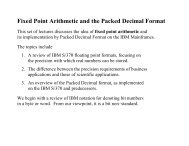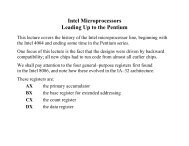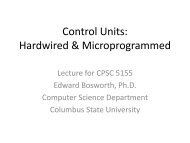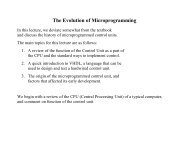PDF Version - Edwardbosworth.com
PDF Version - Edwardbosworth.com
PDF Version - Edwardbosworth.com
You also want an ePaper? Increase the reach of your titles
YUMPU automatically turns print PDFs into web optimized ePapers that Google loves.
Chapter 1 – Why Study Assembly Language?<br />
This is a textbook for a course in assembly language. More specifically it is a course that covers<br />
an older variant (IBM System/ 370 Assembler Language) of the assembly language of the IBM<br />
mainframe series of <strong>com</strong>puters from the System/360 of the 1960’s to the Z–Series of the present<br />
day. The previous statement immediately suggests two questions: what is assembly language<br />
and why should one study it?<br />
In answering these two questions, we mention explicitly the one assumption about the intended<br />
reader of this book, that he or she has programmed a <strong>com</strong>puter in some higher–level language;<br />
possibly Java, C++, Basic, LISP, Python, or COBOL. Other than the fact that each can be used<br />
in a beginning course on programming, the <strong>com</strong>mon feature of these languages is that each<br />
normally considered a higher–level language. The structure of such a language is based on the<br />
class of problems it is intended to solve; the expressions of such a language facilitate formulation<br />
of a solution to the associated problems. Another <strong>com</strong>mon feature of such languages is that each<br />
is built around a core <strong>com</strong>ponent <strong>com</strong>mon to all implementations, though often with extensions<br />
that are specific to a given manufacturer and <strong>com</strong>puter model.<br />
An assembly language and its more primitive variant, machine language, has a structure that<br />
reflects the hardware architecture of a specific <strong>com</strong>puter. While an assembly language might<br />
have constructs that facilitate solution of a specific class of problems, this reflects only the fact<br />
that the underlying hardware architecture has been designed with that goal in mind. As an<br />
example, the assembly language of the IBM mainframe <strong>com</strong>puters contains many features to<br />
facilitate solution of business–oriented problems; this is due only to the fact that the designers of<br />
the <strong>com</strong>puter decided to build a hardware architecture to support these features. It is worth<br />
noting that IBM has elected to use the name “Assembler Language” for what most others call<br />
“assembly language”; the two terms should be viewed as synonymous.<br />
Given the fact that almost all <strong>com</strong>puter programming is now done in a higher–level language, it<br />
is unlikely that any student will spend a significant amount of time either writing or modifying<br />
an assembly language program. Given that fact, we repeat the question “Why study assembly?”.<br />
The answer should be developed historically, beginning with an answer that would have been<br />
given in 1950 and evolving into an answer that is valid today.<br />
In the earliest digital <strong>com</strong>puters any question about an assembly language would not have been<br />
reasonable; assembly language had yet to be invented. Indeed the ENIAC, one of the first<br />
general purpose digital <strong>com</strong>puters, was not even a stored program <strong>com</strong>puter; it was programmed<br />
by connecting coaxial cables and setting switches. Lacking a program memory, the ENIAC<br />
lacked any programming language, including an assembly language.<br />
One of the earliest confirmable uses of assembly language was in the EDSAC, designed by<br />
Maurice Wilkes of Cambridge University (Cambridge, England), beginning in late 1946 or 1947.<br />
The EDSAC Assembly Language was described in 1951 in a book by Wilkes, Wheeler, and Gill<br />
[R_01]. At the time, Wilkes used the term “orders” for what we call “instructions”.<br />
Page 1 Chapter 1 Last Revised November 5, 2008<br />
Copyright © 2009 by Edward L. Bosworth, Ph.D.
S/370 Assembler Why Study Assembly Language<br />
The earliest stored–program <strong>com</strong>puters, the EDVAC and EDSAC, were designed in the late<br />
1940’s. Beginning with these <strong>com</strong>puters, we assume that each <strong>com</strong>puter is programmed in<br />
some sort of language and ask why assembly language might be used. As noted above, the<br />
answer depends on the year in which the question is asked.<br />
Here we must introduce a bit of terminology. Both assembly language programs and high–level<br />
language programs are written first in text that is readable by humans. From this form, it must be<br />
processed into a binary form that can be interpreted and executed by the <strong>com</strong>puter. For assembly<br />
language programs, this process is called assembly and is done by an assembler. High–level<br />
languages are said to be <strong>com</strong>piled into binary form by a <strong>com</strong>piler.<br />
In the 1950’s you would study assembly language because high–level languages were yet to be<br />
developed. Other than primitive binary machine language, assembly language was the only way<br />
to program a <strong>com</strong>puter. FORTRAN (Formula Translation), introduced by IBM in 1957, was<br />
one of the first high–level languages that served as an alternative to assembly language.<br />
In the 1960’s and 1970’s, one would study assembly language for two purposes: either to<br />
maintain a base of legacy code written in assembly language or to enhance the performance of<br />
time–critical parts of code generated by a <strong>com</strong>piler. Most <strong>com</strong>pilers of the time would emit an<br />
equivalent assembly language program prior to conversion to binary machine language. It was<br />
<strong>com</strong>mon practice to edit these intermediate assembly code files and then assemble these, while<br />
discarding the original machine language produced by the <strong>com</strong>piler. In 1972 the author of these<br />
notes used that process to program a PDP–9. The resulting assembly language program executed<br />
at least twice as fast as the equivalent <strong>com</strong>piled FORTRAN code.<br />
Writing in 1979, Peter Abel [R_02] was still able to state that “programs (or even parts of<br />
programs) written in assembler may be considerably more efficient in storage space and<br />
execution time, a useful consideration if such programs are run frequently”. One might note the<br />
considerable advance in <strong>com</strong>piler design of the 1980’s and early 1990’s that increased the<br />
efficiency of <strong>com</strong>piled programs (both time and space) to the level that even the most proficient<br />
programmers have difficulty writing assembly language that is more efficient.<br />
Legacy code continues to be a reason to study assembly language, though increasingly a minor<br />
one. The legacy code problem is a side effect of a design choice best represented by the slang<br />
expression “If it ain’t broke, don’t fix it”. Many <strong>com</strong>panies had a large installed base of<br />
assembly language programs. These programs ran well and produced reliable results. Often<br />
these programs required minor modifications or extensions (such as adding Zip Codes to<br />
addresses). The choice was always either to redesign the code and implement it in a high–level<br />
language, such as COBOL, or modify the assembly language. Since the second option required<br />
much less in the way of programming, it was considered to be the lower risk option.<br />
Prior to the middle 1990’s, there was another very significant reason to study assembly language.<br />
When an executing program encountered an error (such as division by zero, attempting to access<br />
an invalid memory address, or trying to open a non–existent file), it would “abort” and produce a<br />
“core dump”, containing the absolute binary representation of all of the memory address space<br />
allocated to the program. The programmer was required to read this absolute binary, reverse<br />
engineer it to equivalent assembly language code, and determine the offending instruction and<br />
what was to be done to correct the situation. The appearance of modern programming<br />
environments with their sophisticated debugging tools has removed this requirement.<br />
Page 2 Chapter 1 Last Revised November 5, 2008<br />
Copyright © 2009 by Edward L. Bosworth, Ph.D.
S/370 Assembler Why Study Assembly Language<br />
For today, almost no new code is written in assembly language and legacy code has be<strong>com</strong>e a<br />
minor issue. Modern programming environments with their powerful debugging tools have<br />
removed the requirement to read “crash dumps” and convert them to assembly language. Other<br />
than the rather ethically dubious process of reverse engineering <strong>com</strong>mercial code in order to<br />
create unauthorized copies, we must look elsewhere for reasons to study assembly language. For<br />
the students of Computer Science as an academic discipline, there remain a few valid reasons.<br />
1. A knowledge of assembly language can help a programmer be<strong>com</strong>e more proficient in<br />
high–level languages. For example, there are many design peculiarities in the COBOL<br />
language that be<strong>com</strong>e obvious only when one understands the underlying assembler.<br />
2. An understanding of an assembly language greatly facilitates the study of the architecture<br />
and organization of the <strong>com</strong>puter upon which that assembly language is executed. It is<br />
your author’s opinion that a knowledge of assembly language is absolutely essential to<br />
the understanding of how <strong>com</strong>puters are designed and why certain design choices have<br />
been made. Indeed, one essential part of the study of a <strong>com</strong>puter architecture is a study<br />
of its ISA (Instruction Set Architecture), essentially its assembly language.<br />
3. An ability to program in basic assembly language will help the student to understand and<br />
more fully appreciate the services provided by the run–time systems associated with all<br />
modern high–level programming languages. Examples of these services include: file<br />
handling, management of variable–length strings, allocation of dynamic memory,<br />
management of the stack and recursive procedure calls, the function of a relocating<br />
loader and assignment of absolute addresses in memory, DLL (Dynamic Link Libraries),<br />
and many other <strong>com</strong>mon features that are quite useful and often taken for granted.<br />
4. One reason to study IBM System/370 assembler is related to the reason just stated. The<br />
System/370 assembler language is a subset of that used on the more recent and powerful<br />
IBM mainframe <strong>com</strong>puters, variously called either “zSeries” or “Series Z”. The syntax<br />
of the language is rather simple and easy to grasp. The choices made in the design of<br />
this language reflect the choices dictated by the <strong>com</strong>puter architecture of the day, thus<br />
allowing the student to reflect on the interaction of hardware and software design. There<br />
is also the fact that the System/370 assembler language provides very few constructs to<br />
support directly the higher–level constructs <strong>com</strong>mons in a modern run–time systems.<br />
This latter fact allows for programming assignments that use the low–level code to<br />
implement these higher–level functions, possibly leading to a greater understanding.<br />
5. We finally note that there might be some geographic reasons to study System/370<br />
assembler language. From a pure didactic view, this author believes it important for<br />
every student majoring in Computer Science to study and understand some <strong>com</strong>monly<br />
used assembly language. In the Columbus GA area, there are a few large industries that<br />
continue to use IBM mainframe <strong>com</strong>puters and occasionally legacy code written in<br />
assembler language to be modified and extended. For Columbus State University,<br />
the choice of System/370 assembler language is just a reaction to local demand.<br />
As will be<strong>com</strong>e obvious, the focus of this textbook is on writing system code, the interaction of<br />
that code with the ISA of the target machine, and on understanding the functioning of the target<br />
machine at a very deep level. In this, the book differs fundamentally from other excellent texts,<br />
such as the one by Peter Abel [R_02], who appears to expect that his readers will actually use<br />
assembler language to write new financial systems. That is what COBOL is for.<br />
Page 3 Chapter 1 Last Revised November 5, 2008<br />
Copyright © 2009 by Edward L. Bosworth, Ph.D.
S/370 Assembler Why Study Assembly Language<br />
Course Objectives (Learning Out<strong>com</strong>es)<br />
One of the better ways to explain this textbook is to state the learning objectives for the course<br />
for which this text has been written. This course is not a traditional course in assembly language.<br />
While the student is expected to be<strong>com</strong>e somewhat proficient in IBM Mainframe Assembler by<br />
the end of the course, the focus will be on the understanding of 1) the ISA (Instruction Set<br />
Architecture) and 2) the services provided by a modern run time system.<br />
At the end of the course the student will be able to describe and explain the following:<br />
1. The binary representations used by IBM for character, integer, and floating–point<br />
data and how these differ from those used in more <strong>com</strong>mon <strong>com</strong>puters.<br />
2. How to use zoned decimal and packed decimal data. How these differ from and<br />
extend standard two’s–<strong>com</strong>plement arithmetic and standard floating–point formats.<br />
Conversions from any one of these formats to any of the other formats.<br />
3. The IBM view of data organization into fields, records and files.<br />
The assembler declaratives that support record definition.<br />
4. How to edit and assemble a program using the older–style tools associated<br />
with the IBM Mainframe environment.<br />
5. The basic functions of a two–pass Assembler in producing object code.<br />
6. The basic functions of a Link Editor in producing an executable module.<br />
7. The use of the DS and DC declaratives to define and initialize storage.<br />
Understand the importance of boundary alignment in the use of these declaratives.<br />
8. Addressing modes in the IBM 370, focusing on the use of base registers.<br />
9. How to write simple assembler programs that process character and decimal data.<br />
This will include producing and running a number of small assembler programs.<br />
10. How to link separately assembled programs and pass data among them.<br />
11. The basic design and uses of magnetic tape (obsolete) and disk storage.<br />
12. The basic data architecture of the ISAM and VSAM storage methods.<br />
13. The physical and data architecture of physical I/O and data channels.<br />
The remaining learning goals focus on building a modern run–time system.<br />
14. Several methods to represent and process variable–length strings.<br />
15. How to create and process static arrays with automatic bounds checking.<br />
16. How to create and process a singly linked list.<br />
17. How to create and use a stack to store data, addresses, or both.<br />
18. How to write a simple recursive function by explicit use of a stack.<br />
19, How to write reentrant code, which is required for most systems programs.<br />
20. CPU hardware support for the Operating System.<br />
21. Virtual storage (virtual memory) as implemented on the IBM 370/<br />
Page 4 Chapter 1 Last Revised November 5, 2008<br />
Copyright © 2009 by Edward L. Bosworth, Ph.D.
S/370 Assembler Why Study Assembly Language<br />
The Hierarchy of Programming Languages<br />
Another way to view assembler language is to place it in a hierarchy of programming languages<br />
from the very high level languages, down to microcode. Many authors of textbooks on <strong>com</strong>puter<br />
architecture and organization use the term “virtual machine” as a method to express this concept,<br />
though the term does have other uses that are quite distinct. One use of the term as we intend it<br />
here is seen in the name “JVM”, for “Java Virtual Machine”. Java is a popular high–level<br />
language developed by Sun Microsystems, Inc. The method for executing a Java program is first<br />
to <strong>com</strong>pile the code into an intermediate language, called “byte code”. This byte code is then<br />
executed by an emulator called the JVM. To the user, the JVM presents itself as a real <strong>com</strong>puter<br />
with real hardware. In fact, it is a program that executes in the native mode of the host machine.<br />
While it would be quite possible to design an architecture for direct execution of Java byte code,<br />
it has been thought unnecessary to do so. This use of a lower–level machine to give the<br />
appearance of direct execution of a higher–level language is the heart of the virtual machine idea.<br />
The top level of this language hierarchy, though seldom recognized, might be called by a name<br />
such as “<strong>com</strong>puter as appliance”; it just does its job. As an example, consider the secretary<br />
who uses the <strong>com</strong>puter for e–mail, word processing, and financial spreadsheets. The mechanism<br />
by which the <strong>com</strong>puter executes each task is almost unimportant; just get it done.<br />
The top level of the traditional language hierarchy <strong>com</strong>prises problem–oriented languages that<br />
are usually called “high level languages”. Examples of these languages include Java, C++,<br />
Visual Basic, LISP, Snobol, Prolog, FORTRAN, and COBOL. One of the distinguishing<br />
features of such languages is that the syntax and semantics reflect the structure of the problems<br />
most <strong>com</strong>monly solved by those languages. Though many of these languages, especially<br />
FORTRAN, contained extensions tailored to specific <strong>com</strong>puter architectures, in general the<br />
languages are seen as platform–independent.<br />
The language layer below that of high level languages is that of assembly language. The main<br />
distinguishing feature of an assembly language is its close correspondence to the hardware<br />
architecture of the specific <strong>com</strong>puter. While there is one version of Java that can be executed<br />
equally well on a Sun SPARC, Apple Macintosh, Pentium 4, or IBM zSeries; each of these<br />
platforms has its distinct assembly language. None of these assembly languages is remotely<br />
<strong>com</strong>patible with an assembly language on the other platform.<br />
Let us consider a simulation problem, such as weather modeling. Suppose the code is to be run<br />
on an IBM System/370. One way to highlight the difference between a high–level language and<br />
the assembler language is to make the following observation. In order to understand the program<br />
in a high–level language, it is necessary to understand the problem being solved. In order to<br />
understand the program as written in System/370 assembler, one must also understand the<br />
architecture and organization of the underlying hardware.<br />
Assembly language is related to a more primitive variant, called “machine language”. Some<br />
experts consider machine language to occupy a lower level than assembly language; others place<br />
it at the same level. The real difference is that assembly language programs are written to be<br />
read by humans, and use mnemonics that are easy to understand. Machine language programs<br />
are written as a sequence of binary numbers, which are made marginally more readable by being<br />
rendered as hexadecimal (base 16) values.<br />
Page 5 Chapter 1 Last Revised November 5, 2008<br />
Copyright © 2009 by Edward L. Bosworth, Ph.D.
S/370 Assembler Why Study Assembly Language<br />
In order to see the difference between the two (or three) levels of languages, we adopt an<br />
example from the textbook by Patterson and Hennessy [R_04]. We begin with a fragment of<br />
code written in either C or C++ (though some purists claim that neither is high level).<br />
Here is the code fragment, with some reasonable <strong>com</strong>ments added.<br />
swap (int v[], int k)<br />
{ int temp ; // Swap element v[k] with v[k+1]<br />
temp = v[k]; // Save element v[k]<br />
v[k] = v[k+1]; // Move v[k+1] down.<br />
v[k+1] = temp; // Replace the value of v[k+1]<br />
}<br />
Here is the code as written in the assembly language for a <strong>com</strong>puter called MIPS. While most<br />
assembly languages, including both MIPS assembler and System/370 assembler, provide for<br />
<strong>com</strong>ments, this code will not be <strong>com</strong>mented. This translation of the C++ code above is a bit<br />
misleading in that three executable lines are expanded only to seven assembly language lines.<br />
Most expansions are four to eight lines of assembly language for each high–level statement.<br />
swap:<br />
muli $2, $5, 4<br />
add $2, $4, $2<br />
lw $15, 0($2)<br />
lw $16, 4($2)<br />
sw $16, 0($2)<br />
sw $15, 4($2)<br />
jr $31<br />
We now give the translation of this assembly language code into machine language. Each<br />
assembly language instruction directly corresponds to a 32–bit binary machine language<br />
instruction, which we shall represent in hexadecimal form.<br />
00 A1 00 18<br />
00 18 18 21<br />
8C 62 00 00<br />
8C F2 00 04<br />
AC F2 00 00<br />
AC 62 00 04<br />
03 E0 00 08<br />
On all modern stored–program <strong>com</strong>puters, it is a version of the binary machine language that is<br />
executed. The basis of this execution is called either “Fetch/Execute” or some variant of that<br />
name; this is the basic cycle of a modern stored–program <strong>com</strong>puter. Each machine language<br />
instruction is fetched from memory and copied into a special register, called the “Instruction<br />
Register”, where it is decoded and executed. This is the native language of the <strong>com</strong>puter.<br />
As a historical fact, the languages were developed “bottom to top”, with machine language being<br />
the first developed. Almost immediately, assembly language was developed mostly because it<br />
used mnemonics and was much easier for a human to read. High–level languages were a later<br />
development. Recent research and development related to high–level languages has focused on<br />
more sophisticated <strong>com</strong>pilers and support for parallel processing.<br />
Page 6 Chapter 1 Last Revised November 5, 2008<br />
Copyright © 2009 by Edward L. Bosworth, Ph.D.
S/370 Assembler Why Study Assembly Language<br />
We shall now mention a few of the more obvious differences between high–level languages and<br />
assembly languages. We begin with the definitions of the process that converts the language into<br />
the machine language that is ready to be loaded into memory and executed. By definition, all<br />
high–level language programs are said to be <strong>com</strong>piled, while assembly language programs are<br />
said to be assembled. While this difference may seem to be just one of semantics, we shall<br />
quickly see that <strong>com</strong>pilers are usually much more sophisticated than assemblers.<br />
We now ask about the output of the <strong>com</strong>piler. In this context, we have two basic options: either<br />
machine language or assembly language that is then assembled. The option chosen by IBM is<br />
for each <strong>com</strong>piler to emit assembly language, which is processed by a <strong>com</strong>mon assembler.<br />
Some of the other more <strong>com</strong>mon differences between <strong>com</strong>piled and assembled languages are:<br />
1. Assembly language statements almost always map one–to–one into machine language<br />
statements; one assembly language statement generates one machine language word.<br />
High–level language statements usually generate a number of machine language words,<br />
<strong>com</strong>monly in the range 3 to 8; with more being possible.<br />
2. High–level languages provide for the declaration of variables by types and associate<br />
the proper operations with them. Assembly languages provide only for the allocation<br />
of storage space and rely on the assembly language instruction to be specific about the<br />
data type. In other words, high–level languages select the operation appropriate for the<br />
type of the variable, while the assembly language uses the operation specified.<br />
3. Compilers for high–level languages have be<strong>com</strong>e quite sophisticated in the optimal<br />
use of system resources, such as the general purpose registers in the CPU. This usually<br />
leads to executable code that is quite efficient. It is worth noting that many early<br />
<strong>com</strong>piler writers considered the problem of optimal register allocation to be unsolvable,<br />
until one bright designer recognized it as the equivalent of a well known problem in<br />
mathematical graph theory. Once this was seen, the problem was easily solved.<br />
4. It is said that <strong>com</strong>pilers are yet to be<strong>com</strong>e sufficiently sophisticated in allocating<br />
resources for parallel execution on a multi–CPU (or multi–core) <strong>com</strong>puter. While<br />
assembly language programs can allocate the resources explicitly, your author expects<br />
considerable progress to be made in <strong>com</strong>pilation for parallel execution.<br />
5. The code for every operating system does require some basic operations, such as<br />
interrupt management, that are not easily provided in a high level language. For this<br />
reason, one may expect assembly language to play a minor part in all future systems.<br />
Page 7 Chapter 1 Last Revised November 5, 2008<br />
Copyright © 2009 by Edward L. Bosworth, Ph.D.
S/370 Assembler Why Study Assembly Language<br />
Let us consider the second point by assuming a machine, such as the System/370, that supports<br />
both 32–bit integer arithmetic and 32–bit floating point (real) numbers. Consider the following<br />
fragment, written in a FORTRAN–like high level language.<br />
X = 2<br />
Y = 3<br />
Z = X + Y<br />
The values 2 and 3 are integer constants. The symbols X, Y, and Z represent variables. The<br />
<strong>com</strong>piler allocated 32–bits (four bytes) for the storage of each, as will the assembler. However,<br />
the <strong>com</strong>piler will use the variable type declarations (either implicit or explicit, as in Java) to<br />
determine the operations. If all of X, Y, and Z represent integer variables, the first two<br />
assignments are quite simple and it is integer addition that is invoked.<br />
Suppose now that each of X, Y, and Z represent real numbers. The first two assignment<br />
statements involve conversion of the integer values to the equivalent real number values,<br />
2.0 and 3.0. Most modern <strong>com</strong>pilers will do this at <strong>com</strong>pile time, thus avoiding the overhead of<br />
run–time translation. The addition is now the operation appropriate for real numbers.<br />
Note again the fact that it is the type declarations for the variables that determines what type of<br />
assembly language is emitted by the <strong>com</strong>piler for the three statements being considered.<br />
We close this section by mentioning a newer assembler language developed by IBM and stating<br />
the reasons that it might be preferable to a high–level language. Here, we must note that the<br />
author of this textbook has no experience directly related to these arguments, but finds them<br />
quite plausible. These reasons are taken from a presentation by Kristine H. Neely [R_03]<br />
1. HLASM, the new High Level Assembler, now directly supports all of the<br />
structures required for structured programming. Multiple direct branches are<br />
no longer required.<br />
2. HLASM can create programs that “break” the addressing limits imposed by<br />
some high–level languages. This may be called the “2 GB bar”.<br />
3. HLASM has provisions for explicit control of multiple processors operating in<br />
parallel. At present, the facilities offered by high–level languages lack the<br />
sophistication that can be explicitly achieved by programming in HLASM.<br />
[Your author’s note: This may change soon.]<br />
The introduction of this new high level assembler raises the question about the <strong>com</strong>plexity<br />
desired in a modern assembly language. A number of modern assemblers, such at the IBM<br />
product HLSAM, contain almost enough features to rank them as high–level languages. There<br />
are two variants of this <strong>com</strong>plexity problem, only one of which having an obvious answer.<br />
1. The first variant is similar to that seen in the VAX/11–780 and other members of the<br />
VAX family (often called “Vaxen” by pundits familiar with German). Here, the <strong>com</strong>plex<br />
assembly language is a direct result of the <strong>com</strong>plexity of the underlying machine. One<br />
of the standard results of modern <strong>com</strong>puter design theory is that <strong>com</strong>plex machines are<br />
less desirable than machines more simply designed; simpler means faster.<br />
2. The second variant calls for the <strong>com</strong>plex assembly language to be processed by<br />
sophisticated pre–processor into a simpler standard assembly language. This approach<br />
has no implications for the underlying machine.<br />
Page 8 Chapter 1 Last Revised November 5, 2008<br />
Copyright © 2009 by Edward L. Bosworth, Ph.D.
S/370 Assembler Why Study Assembly Language<br />
What Lies Beneath<br />
The student of <strong>com</strong>puter architecture will realize that the hierarchy of languages does not convey<br />
the whole story about hardware and software architecture. We have taken this hierarchy down<br />
only to the machine language level. Below that level, lie a number of very important levels.<br />
The microarchitecture level deals with the control structures that cause the <strong>com</strong>puter to execute<br />
the instructions found in the sequence of machine language words.<br />
The device level deals with the construction of the circuits used by the microarchitecture in order<br />
to execute the machine language. These are built from basic devices, often called “logic gates”.<br />
The electrical engineering layer deals with how to fabricate the basic devices (or gates) from<br />
the basic circuit elements: transistors, resistors, capacitors, inductors, and conducting traces.<br />
The solid state layer deals with how to fabricate basic circuit elements with new desirable<br />
qualities. Normally the requirement is either that they be faster or dissipate less heat.<br />
A course in Computer Architecture and Design (such as CPSC 5155 taught at Columbus State<br />
University in Columbus GA) will address issues in the microarchitecture level and device level.<br />
Any course in assembly language must stop at the machine language level.<br />
Page 9 Chapter 1 Last Revised November 5, 2008<br />
Copyright © 2009 by Edward L. Bosworth, Ph.D.













